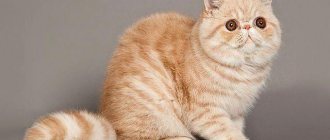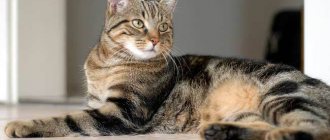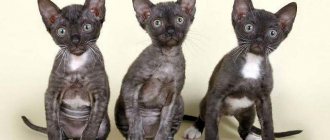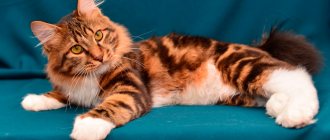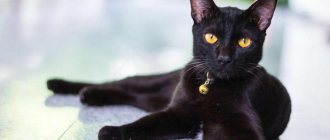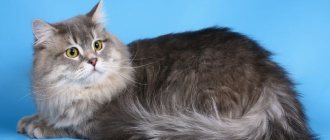Author: Barfik
Munchkins are a fairly rare breed of short-legged cats. People often call them dachshund cats. However, this definition is not entirely accurate. Short-legged dog breeds have an elongated body, but munchkin cats are constitutionally no different from their counterparts, with the exception of the length of their paws. These cats do not belong to selective breeds; they appeared as a result of a spontaneous mutation.
These cats are born due to the presence of a dominant achondroplasia gene: when one of the parents has such a gene in the genotype, there is a high probability of short-legged cats appearing among the offspring.
Types of short-legged cats
Cats with short legs come with long and short hair. It depends on who became the parent of the animal. The munchkin is considered the progenitor of all cats in this family.
Short-legged cat
In 1983, a music teacher in the United States saved a pregnant cat from a dog. The animal had rather short front and hind legs. After some time, kittens appeared, among which there was one with the same paws as his mother. He received the name Toulouse and became the father of the next short-legged generations.
In 1991, the breed became known as the Munchkin and was officially recognized and registered. Scientists wanted to know why such animals appeared. After all the research, they came to the conclusion that this is not a pathology, but nature, or rather simply physiological characteristics. Short-legged cats often have quite ordinary kittens with normal leg length.
Interesting! When munchkins were crossed with other breeds, new types of kittens appeared that had distinctive characteristics.
Longhair
Animals with long and medium hair were bred by crossing munchkins with Persian cats and other breeds with abundant hair. Some cat breeds obtained as a result of experiments are still not official. However, they are also popular and require attention and care.
Shorthair
All types of short-haired cats with small paws were created by crossing munchkins and sphinxes. Such cats have short legs and almost complete absence of hair. But this does not in any way affect their character and lifestyle, which makes such pets quite popular.
Short-legged kittens are very cute
Munchkins, or Understated cats
In fact, undersized cats are a very rare and unique breed of cat with short legs - the Munchkin. Quite often they are called “dachshund cats.” This definition is not entirely correct. Dogs with short legs have an elongated body, while cats are naturally endowed with a normal-sized body. This is not a selective breed. It appeared as a result of a spontaneous mutation.
History of the breed
In the forties of the twentieth century, cases began to be recorded when undersized cats appeared in a normal litter - animals with short legs. This began to happen in different parts of the Earth. In 1944, a British veterinarian described four generations of these animals. They were completely healthy and differed from other animals only in the length of their paws. In nineteen eighty-three in Louisiana, a woman adopted a pregnant stray cat. She gave birth to babies in her house. Half of the offspring were undersized cats (munchkins).
First appearance in public
The general public saw these animals for the first time in 1991 at an international cat exhibition. Opponents of the breed argued that further breeding of these individuals spoils the health of the animals and threatens them with deformities. One of the judges resigned in protest, announcing this right at the exhibition. He called the unusual breed "an insult to breeders." Immediately after this scandal, understated cats (munchkins) were carefully studied in the laboratory of the University of Kansas. No abnormalities in the health of the animals were found.
Official recognition
As a breed, understated cats (munchkins) were recognized in 1995 by TICA. Meanwhile, many associations in the world are still against this. This is probably why these animals are extremely rare in European countries. However, all the controversy among experts does not prevent munchkins from arousing a feeling of sympathy among ordinary cat lovers. These are very playful, good-natured and affectionate creatures.
Character and habits
An understated cat (Munchkin breed) is an amazing animal. The owners claim that they adopted many habits from dogs. They are happy to walk with their owner on a harness, are always peaceful and friendly towards other animals, and easily adapt to a new environment.
The understated cats, photos of which you see in this article, are devoted companions. They love to travel, provided that their beloved owner is nearby. The animals are very mobile and can easily jump onto fairly high surfaces. True, it is difficult for them to descend later due to their unusual body structure, so they do it much like martens. Owners of munchkins need to know that falling from a height can cause serious injuries for these animals, so it is better not to leave them unattended outside.
Breed Features
It's interesting to watch these animals from the outside. To look around, they sit on their hind legs, and at this moment their tail serves as a kind of support for them. They can sit in this position for quite a long time. Due to their short legs, munchkins are not very good hunters, but they have one rare and amazing feature. Like magpies, they collect small things and hide them in a secluded place known only to them.
Undersized cats (munchkins) come in semi-longhair and shorthair. The colors of these animals are very diverse.
Character of short-legged cats
Castration of a cat: features of preparation for the procedure and further care
Small cats have a friendly and cheerful character. These are cheerful and intelligent creatures that will give their owner a lot of positive emotions. Despite their short legs, cats are quite mobile and easily climb up. A distinctive feature of such pets is their curiosity. Due to the structure of their body, they have to stand on their hind legs to look around.
All animals of the family are very affectionate and attached to the owner. However, they are quite silent and will never scream to attract attention to themselves. They easily get used to a new place and tolerate travel well.
Short-legged cats love to make hiding places, so you should be careful about the things around you. Otherwise, the pet will hide them in its secret place.
Habits and character
Many owners clearly see canine traits in their pets - munchkins love to walk on a harness, are peaceful with other animals, and easily adapt to new surroundings. These cats are excellent companions and can easily endure travel and trips. They are quite mobile, quite capable of jumping onto high surfaces, but they descend from there in a completely unusual way - like a marten, due to the non-trivial structure of the body. At the same time, a fall from a height can cause serious damage to munchkins, and it is not advisable to keep these purrs outside.
The munchkin (also known as the understated cat) got its name in honor of the short characters from the children's book "The Wizard of Oz."
The habits of this breed are especially interesting. For example, to look around, cats sit on their hips and use their tail as a kind of support to maintain balance. This adds to their resemblance to meerkats. Moreover, tailed animals can remain in this funny position for quite a long time. Naturally, short legs do not help munchkins to be good hunters, however, these purrs have a funny feature - like magpies, they love to collect small things and hide them in secluded places.
The spine of cats is not affected by the mutation and is flexible.
Color of cats
Wild cats: species of cats in nature
There is no official color for short-legged cats. The development of the breed occurs according to a specific program “OUTCROSS”, where crossing with any animal of the cat family is allowed. For officially registered breeds, there are a number of specific characteristics that they must meet.
Minskins have a very interesting appearance
Official breeds of short-legged cats
Not all breeds of short-legged cats are officially recognized. There are 6 main species, the rest have names and distinctive features, but are not registered.
Munchkin
Hairless cats: history of the breed and maintenance features
Cats of this breed are the progenitors of all species with short legs. They are characterized by the presence of the following symptoms:
- short stature;
- rounded chest;
- the head is wide, the muzzle is small, the forehead is flat, the nose is medium in size;
- the ears are triangular in shape and arranged vertically;
- the eyes are large, the color depends on the general color of the cat;
- the tail is small and rises up when walking;
- weight ranges from 2 to 4 kg, females are smaller than males.
Munchkins are very kind and active animals with a calm character. They are attached to the owner, socially adapted and communicate well with the whole family. Munchkins also quickly make friends with other pets; they are not jealous or vindictive.
Interesting! These cats are most often used for breeding as carriers of the gene for short legs.
Minskin
Minskin cats were obtained by crossing Munchkins and Canadian Sphynx cats. From some he received small paws, from others he received almost complete absence of hair. After some time, a couple more species were added to the selection - Devon Rex and Burmese. Minskins are characterized by the presence of small hair on their paws and ears, which is why cats are often called hobbits.
The weight of pets does not exceed 3 kilograms. These babies are friendly and love their owners very much. They also treat other family members kindly and get used to them easily.
Important! Animals do not tolerate loneliness well; it is not recommended to allow them to be alone for a long time.
Minuet
Short-legged cats of the Minuet breed are distinguished by thick and beautiful hair. Fluffy beauties were obtained as a result of the combination of munchkins and Persian cats. The breed was originally named "Napoleon" in honor of Napoleon Bonaparte. Officially recognized in 2005. However, in 2020, this type of cat received a new name - minuet.
Pets are small in size, have short legs and long hair. From Persian cats the animals received a flat muzzle and round eyes.
Fluffies have a wonderful disposition, they are affectionate and gentle. They are quite strongly attached to their owner, but easily accept other family members. These cats are not aggressive at all, communicate well with children and are able to endure all their games.
Due to their body structure, cats with short legs sit like meerkats.
Skookum
A peculiar breed of cats with short legs, obtained by combining a munchkin and a curly laper. The result was babies with curly hair. In this case, the length of the fur can be of different lengths.
Interesting! The breed was officially recognized only in 2006, 10 years after the appearance of the first kitten.
Skookum has a larger weight (up to 4 kg). It is worth noting that the longer a cat's fur, the more it curls.
Cats are active and friendly, they love to play with everyone, without singling out anyone separately. They communicate well with other animals and small children. A distinctive feature is considered to be a fairly quiet voice; cats meow quite rarely.
Kinkaloe
The combination of the Munchkin and the American Curl gave rise to a new species - the Kinkalow. This is a fairly new breed, so there are not many similar understated cats.
A distinctive feature of the kinkalow is the ears - immediately after birth they are straight, and after a couple of weeks they begin to bend, gradually forming an angle from 90 to 180 degrees. Full formation occurs by 5 months
Six fold-eared pets of this breed are fluffy and shiny. The weight is small - up to 3 kg.
Cats have a calm character, love to play, and accept other pets normally. Cats immediately choose their only owner, whom they love very much and are sad without him. They treat other family members friendly and do not show aggression.
Kinkaloo cat
Dwelf
Dwelf cats combine the characteristics of three species - Munchkins, Canadian Sphynxes and American Curls. As a result of such crossing, cute kittens with short legs, lack of hair and curled ears were obtained.
Despite their unusual appearance, Dwelfs are very similar to other breeds of short-legged seals. They are affectionate, kind and cheerful. They always choose one owner for themselves, but they treat other family members and animals very well.
Important! Dwelfs have a very vulnerable psyche, they do not like loneliness and can get offended, so you should treat them carefully and not leave them alone for a long time.
Dwelfs are like space creatures
Features of care, breathing problems in brachycephals
The structure of the skull affects not only the appearance, but also the life activity of animals. Thus, the flattened muzzle of cats, although attractive in appearance, has a lot of disadvantages and makes the pet dependent on its owners.
Care in this case will include the following aspects:
- Increased tear production increases the risk of infection under the eyelids, and the eyes may begin to fester. To avoid complications, you need to wipe them with a soft cloth or paper napkin, after wetting them with special drops.
- Prevention of stones and plaque on teeth involves the presence of dry food in the cat’s diet. You can use chewing toys to clean your mouth and use a brush designed for this purpose once a month.
- Ear examinations should also be done regularly. To clean once a month or when soiled, use cotton swabs moistened with alcohol-free products or petroleum jelly.
- To maintain healthy claws, a scratching post is necessary. And once a month you will need a nail clipper to trim them. In this case, you cannot capture more than 2 mm, and the cut must be even, at a right angle.
- The coat needs to be brushed constantly to avoid tangles: long coats daily, and medium coats 2-3 times a week. To do this, you should take turns using combs with sparse teeth and brushes with frequent teeth. The procedure begins with the head, moving to the back, chest and other parts of the body.
- To keep the fur clean, water procedures should be carried out once every 2-3 months. To do this, pour no more than 10 centimeters of liquid into the bath, because you cannot completely wet the cat so that water does not get into the ears. After soaping it, you should thoroughly rinse and dry your pet’s fur.
- The diet can include natural food or ready-made food. Lean frozen boneless meat, vegetables, fermented milk products, boiled eggs, and cereals are allowed. It is better not to give smoked, sweet and fatty foods, and limit the amount of fish.
The downside for cats with brachycephalic faces is breathing problems. Narrow airways make it difficult for them to breathe.
Obvious signs of this are snoring, snoring during sleep or while eating food. With a cold, there is a tendency to nasal congestion, which significantly worsens the animal’s quality of life. Therefore, when choosing a similar pet for yourself, you should carefully monitor the air temperature in the house or apartment and prevent it from becoming hypothermic.
Health
The average lifespan of cats with short legs is 13 to 16 years. Despite the fact that scientists were quite skeptical about such animals, their health is quite normal.
The most common disease in cats is considered to be “lordosis”. When it occurs, a serious bending of the spine occurs, the ridge begins to put pressure on the internal organs, causing discomfort and pain in the animal.
The causes of the disease are obesity and a sedentary lifestyle, so you need to carefully monitor your pet and its diet.
Interesting! Often, anomalies arise as a result of mating animals. Such cats are subsequently sterilized to prevent reproduction.
Skookums have curly fur.
Features of care
Short-legged cats are very unpretentious in everyday life, so care for them can be quite ordinary. Depending on the breed, it includes the following items:
- Long-haired and short-haired cats are combed once a week; during the molting period, the procedure is carried out more often,
- The cat should be bathed no more than once every 4-6 months; pets without hair can be periodically wiped with a damp cloth,
- Be sure to keep an eye on the eyes and clean them if necessary, especially for animals with long hair,
- Once every 10 days, clean the ears using cotton swabs,
- If necessary, trim the claws.
Interesting! It is recommended to carefully monitor the diet of short-legged cats and include various mineral and vitamin supplements in their diet in a timely manner.
History of the breed
Since the 40s of the twentieth century, short-legged cats began to appear in different parts of the world. In 1944, a British veterinarian wrote about four generations of such cats, which were absolutely healthy and differed from their counterparts only in the length of their limbs. Later, in 1983, in Louisiana, an American woman found a pregnant cat hiding under a truck from a bulldog that was chasing her. The woman took pity on her and took her to her home. When the cat gave birth to kittens, half of them were short-legged. Such an accidental mistake of nature gave impetus to the beginning of the formation of the munchkin breed.
This species was introduced to the general public only in 1991 at the exhibition of the International Association of Cat Fanciers in Madison Square Garden. Skeptics of that time argued that breeding short-legged cats could lead to deformities and spoil the health of the animals, causing problems with the spine and paws. In protest, one of the judges resigned right at the show, calling the breed “an insult to breeders.” But after conducting medical research at the University of Kansas, it turned out that short legs do not limit the mobility of cats and do not affect their life. Also, no matter how they studied the unfortunate cat, the researchers did not notice any problems with the spine, which are characteristic of short-legged dog breeds - corgis and dachshunds.
Features of choosing kittens
Cats with short legs have gained popularity and become desirable for many people. However, you also need to purchase them carefully.
How to choose a nursery to buy or buy secondhand
It is better to purchase a real kitten from a specialized nursery, and not from someone else. Unfortunately, there are quite a few such establishments in Russia, so it is better to look for an animal in other countries. You need to make sure that the institution and the future pet have all the documents.
Buying it secondhand is fraught with the risk of receiving a sick baby who is passed off as healthy, but elite and purebred.
How much do these breeds most often cost?
The cost of short-legged kittens varies from 5 thousand rubles*. Only animals with any deviations from breed standards are sold cheaper. Approximate prices for kittens:
- Napoleon - from 30 to 80 thousand rubles;
- munchkin - from 5 to 30 thousand rubles;
- kinkalow – from 500 to 1000 euros;
- Skukum – from 800 to 3500 euros.
